The Decisive Moment: History Within a Photographic Concept
Henri Cartier-Bresson regarded his decisive moment concept as, ‘the simultaneous recognition, in a fraction of a second, of the significance of an event as well as the precise organisation of forms which gives that event its proper expression’ [1]. Cartier-Bresson further explained the decisive moment is universal, that ‘there is nothing in this world that does not have a decisive moment’ [2]. Cartier-Bresson clearly saw photography containing a capability to document everyday life, where even mundane scenes can be defined through their decisive moments. Everyday life within photography contains a universal quality regarding the decisive moment concept means photographs of historical significance can also apply. Historical photographs, which document significant persons or events, contain decisive moments which enhance their historical context towards future generations. Photography being able to capture significant persons or events in decisive moments reflects an emotive core, which takes places everywhere in the world, as Cartier-Bresson noted the decisive moment concept has a universal quality. Without photographs of decisive moments, future generations would not be able to comprehend historically decisive moments with accuracy.
Significant Persons
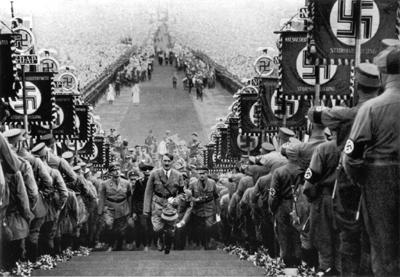
The decisive moment within photography regarding significant persons has the capability to capture their personality and power, for future generations to gain an indication of their character. Adolf Hitler certainly is a significant person in history and photography was used to reflect his consolidation of power. Photography is a medium which strengthens a person’s or institution’s image for propaganda purposes. Hitler was masterful at manipulating propaganda to portray himself as a dominant individual, along with reflecting the Nazi party as an established force. Heinrich Hoffman was Hitler’s personal photographer, documenting Hitler’s dictating grip over Germany, as shown in Hitler at Buckeberg. Don Nardo noted Hoffman ‘recognised the power of capturing notable people and events in a candid way, as they happened. These would give the public and future generations a good idea of what the people and events were like’ [3]. This analysis in relation to decisive moments in photography reflects Hoffman’s ability to capture significant moments. Hoffman represented Hitler as a significant person by capturing him during moments where he received respect. Hoffman capturing Hitler being honoured by Nazi troops in a wide shot. In the background, a mass of Nazi supporters and Hitler’s subordinates look on obediently at their fuhrer. The wide shot was useful for Hitler’s propaganda as it reflects the rally’s significance as a continuation of Hitler’s consolidation for power. Hoffman makes Hitler the centerpiece of Hitler at Buckeberg, reflecting the expression of Hitler’s power through the Nazi troops and supporters.
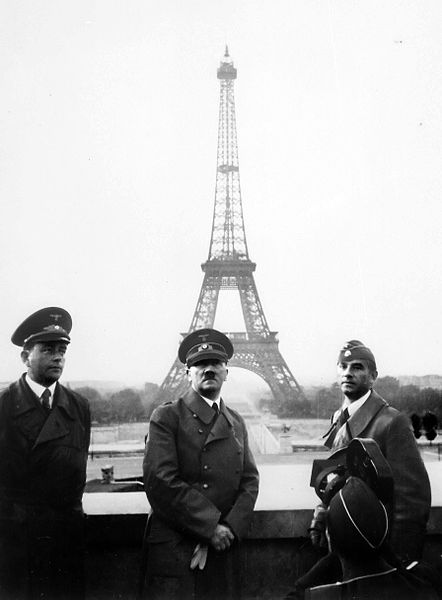
Hoffman continued to use his photographic techniques for propaganda in defining Hitler as significant within decisive moments, as shown in Hitler in Paris. This photograph emphasises Hoffman’s ability to capture precise moments of significance, in accordance to the decisive moment concept. It documents the Nazi’s occupational success over France, reflecting Hitler’s power as vital towards Nazi consolidation across Europe. Hitler is shown in the foreground as central to Nazi occupational success, surrounded by his subordinates. The Eiffel Tower behind Hitler symbolises France’s fall into Nazi occupation. Hitler in Paris contains the decisive moment through portraying Hitler as a significant person towards the Nazi’s occupational success over France. The composition of Hitler and his subordinates with the Eiffel Tower in the background embodies Nazi occupation of France as absolute.
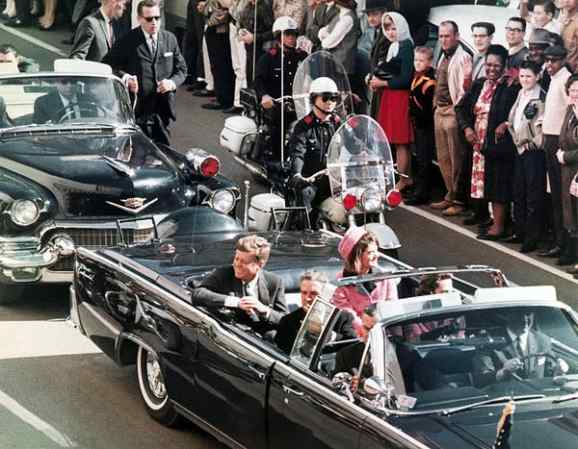
The decisive moment regarding significant persons can also be applied retrospectively, if the precise organisation of forms express it. These can be an understanding future generations have of an historical event whilst it unfolded. One instance where this applies is JFK’s assassination, which became a horrific and unexpected incident. JFK’s assassination, retrospectively through photography, lets future generations understand the shock and horror experienced by those who witnessed it. Since Kennedy Before Assassination captures JFK’s final moments, future generations viewing the photograph will understand the precise organisation of forms can convey an underlying tragedy. They can observe the positive environment within Kennedy Before Assassination as JFK and Mrs Kennedy smile at Dallas spectators, which have a harrowing poignancy. It is poignant for future generations as they realise Kennedy Before Assassination contains a deep sadness, as they know the celebrations were soon to be cut short.
Aftermath of JFK’s assassination captured the shock of those close to JFK. It enhances for future generations the sadness of celebrations cut short in Kennedy Before Assassination, as everyone was horrified by his sudden death. Aftermath of JFK’s assassination shows Lydon B. Johnson, Vice President to JFK, being sworn in as President with a sad facial expression. Mrs Kennedy, acting as a witness to the event, looks dazed because she was still affected by her husband’s death. Johnson and Mrs Kennedy are central to Aftermath of JFK’s assassination as their expressions reflect the shock experienced through JFK’s assassination. The background of fellow witnesses and reporters stood in stunned silence, continuing to express shock by JFK’s assassination. Aftermath of JFK’s assassination emphasises for future generations the tragedy of JFK’s assassination, a decisive moment in American history as JFK’s death deeply affected his family, associates and the nation, in turn showing the magnitude of JFK’s character.
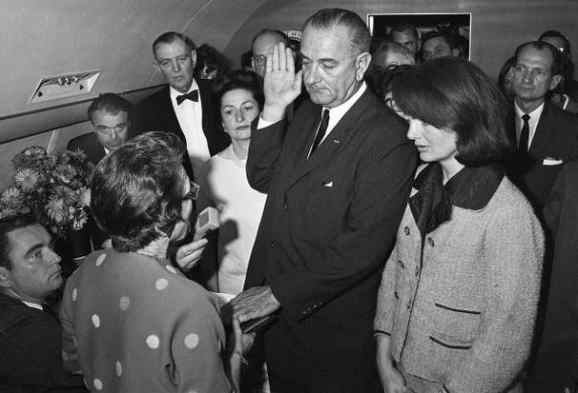
Representing Events in Their Proper Expression
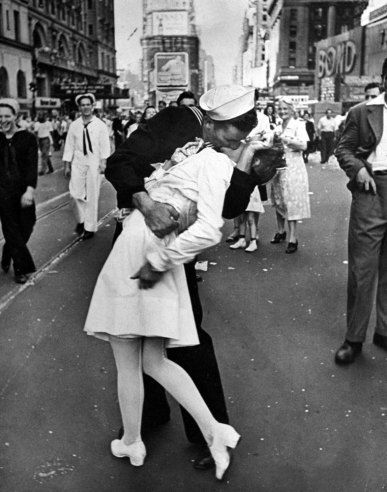
The decisive moment in photography does not always have to contain significant persons. If photography is able to convey expressions of an historical event through emotive action, then it is capable of documenting decisive moments. VJ Kiss in Times Square reflects American optimism following the end of their involvement in World War Two. A sailor and nurse, both of which would have served in America’s war effort, embrace each other. Their embrace was deeply passionate reflecting the sheer joy of American citizens, as the couple embracing openly showed the surge of liberation due to the war’s end. The background reveals fellow American citizens smiling at the site of this passionate embrace, continuing to reflect America’s optimism and liberation. The concepts of VJ Kiss in Times Square are also reflected in VJ Day in Times Square, as future generations can understand America’s relief circa 1945.
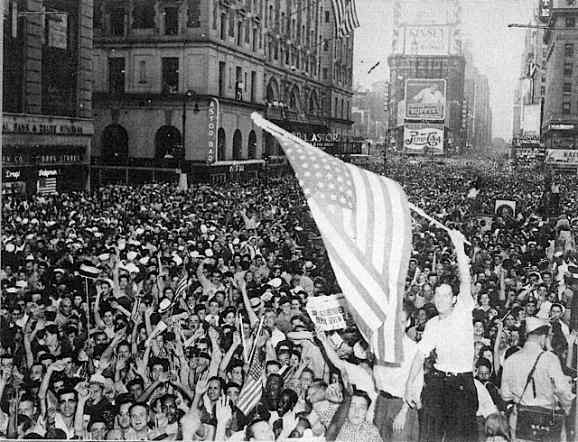
It goes without saying American citizens celebrating their military victory was a decisive moment. VJ Day in Times Square reflects the event’s significance as celebrations shown in the wide shot capture a mass section of American citizens united in celebration. The wide shot reflects the extent of America’s shared emotions for optimism and liberation. However, even more significant in expressing this decisive moment are those in the foreground. The man holding an American flag expresses an overwhelming pride felt by his fellow Americans. VJ Day in Times Square certainly contains the emotions which ran across America following their military victory.
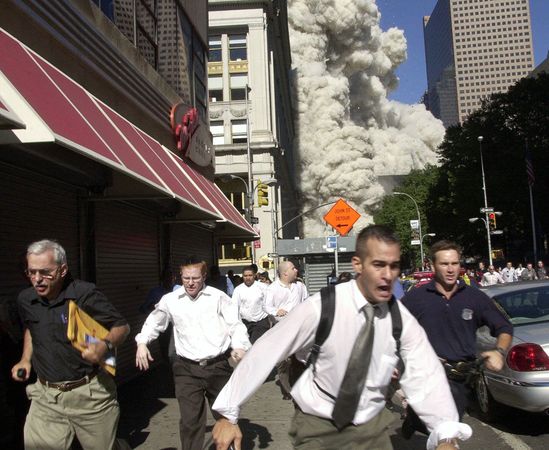
Running for their lives enhances representations of 9/11 through expressions of terror upon those who were involved. For those who remember 9/11, they will always contemplate its harrowing terror and immense global shock. However, for those too young or not yet born, photographs like Running for their lives document 9/11 for their understanding. The photograph manages to capture New York citizens fleeing in fear, shown on their facial expressions and frantic body movements, which can be understood by the ash cloud heading towards them. The composition of New York citizens escaping the emerging ash cloud can help those wanting to contemplate 9/11 as a distressing, historical event.
Enveloped in Ash is an extremely poignant photograph documenting experiences of a female New York citizen. She is covered in ash, which also consumes her surroundings. This alone is horrific enough, yet the woman’s shocked glance directed towards the camera gives Enveloped in Ash a deeply emotive impact. It is her glance which expresses 9/11’s impact upon New York citizens for those wanting to contemplate the surreal moments and distressing emotions involved.
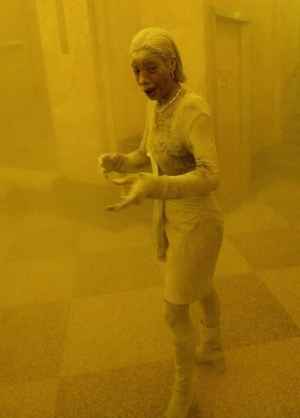
Henri Cartier-Bresson’s concept of the decisive moment through photography illustrates the capability of documenting decisive moments in any scenario, due to its universal quality. As this article has displayed, historical photography also applies towards the decisive moment concept because future generations can become informed. The decisive moment regarding significant persons in history helps future generations become associated with the effect they had upon others, such as Hitler’s totalitarian presence or JFK’s charisma. As for decisive moments within significant historical events, photography was able to convey a nation’s emotions at specific historical moments. Photography capturing decisive moments are vital for future generations in understanding history with accuracy. Without it, there would not be a visual historical document to help future generations contemplate.
Works Cited
1. Anonymous., 2014. ‘Talk: Henri Cartier-Bresson’, en.wikiquote.org. [Online][Available From]: http://en.wikiquote.org/wiki/Talk:Henri_Cartier-Bresson
2. Cartier-Bresson., H. 1952. The Decisive Moment. Simon and Schuster.
3. Nardo., D. 2014. Hitler in Paris: How a Photograph Shocked a World at War. Compass Point Books.
What do you think? Leave a comment.










Interesting ideas! I’m working on a piece about the Humans of New York photoblog, and the points in your article were really relevant to what I’ve been writing about. great work 🙂
saw some of the best and most famous prints of Henry Henri Cartier-Bresson couple of days ago! Wow! Check em out when you can at A Gallery for Fine Photography in the quarter…
Thought. Do you believe that Bresson’s photography worked because his philosophy worked? He was a socialist. Socialists appreciate the common man.
Great post.
Enveloped in Ash is a terrifying shot.
It certainly is. I was immediately affected by the photography as soon as I saw it.
My list of Favorite Photographers:
1.Saul Leiter
2.Fan Ho
3.Don McCullin
4.Elliot Erwitt
5.Sebastião Salgado
6 Henri Cartier-Bresson
7 Helen Levitt
8.Vivien maier
9.Andre kertesz
10.Steve McCurry
Henri is perhaps the most humanistic of the great street photographers in history.
Having just viewed Henri Cartier-Bresson’s amazing photography exhibition in Paris
I am in awe of his pictures incorporating geometry but leaving an element to chance to complete his pictures
Thanks for the article. Henri Cartier Bresson is an interesting photographer. For example, the way ignored the usual photojournalistic icons/props, for example at the coronation of King George VI he concentrated on the crowd rather than the king.
I love his photos … for me, he is the father of photography.
Fantastic post. Really enjoyed reading it.
Really interesting article, insightful and very well structured. I like how you’ve based yourself on the photos and weren’t afraid to put them in large. Well done!
Thanks Rachel
Ryan thank you for this information and your selection of photographs are decisive.
Thanks Venus
With the prevalence of cameras in today’s society and with increasingly greater access to the Internet, the way we store and access historical information like photos has changed. Positively, digital archives are often larger, more varied and inclusive than conventional archives, allowing ordinary or marginalized people a more prominent part in the history dialogue. However, the sheer amount of images often leads to a problem of quality and relevance that selection criteria cannot always resolve. Indeed, such systems of storage often lack the selection bias of an expert team of curators. Moreover, certain older, less educated or less financially stable people may not have access to the necessary technology, a technology that is constantly changing, updating and becoming obsolete. The future and preservation of such an enormous photographic record, with all its different perspectives, isn’t necessarily secure.
Cartier-Bressons’s theory (for that is what it is) leaves out the important consideration that a ‘decisive moment’ photo may acquire significance because of the elements that are not present. Clearly, in the early years of photography, self-consciously decisive moment photos were going for the monumental, because they were competing with marble and oversized frescos. The difference is that the latter had to strive for a depiction of sheer spontaneity, while the former–photographs–had this feature built into them. One can appreciate this difference in terms of what is missing in earlier photographs by noticing the difference between, say, the above pic of just prior to the Kennedy assassination with the pic of Archduke Ferdinand mounting his royal carriage just before his assassination in Serajevo, the event that launched the war resulting in the deaths of millions due to squabbles within European royal families Europe still hasn’t really recovered from. In this photograph, a pompous elderly man in undersized military garb weighed down by meaningless medals displays a rectitude of tradition that in the end spelled the deaths of millions. The picture is of the decisive moment when black comedy became incipient tragedy. The Kennedy pic presupposes more than it says: America until that moment was bright and gleaming, full of sharp light and good intentions. But it is a picture of a yesterday no one doubts could also be a picture of a future tomorrow, and for that reason isn’t precisely a pic of (what von Clausewitz would call) “der Schwerpunkt” at all. A better example of ‘the decisive moment’ being captured where all is said and nothing is really known in spite of the presence of all the elements rendering it definitionally so would be the famous pic of Ruby shooting Oswald in the Dallas police department basement. Histrionic by accident, monumental in its stupefaction (like the Laocoon), yet fifty years later we can ask ourselves “Who really was Oswald?” or “Who really was Ruby, anyway?” and find ourselves no closer to a clear answer now than we could be then. Reality is captured in an instant, is in fact that instant in all its meaning, but it is so because of the import of the elements that are missing. These missing elements give these pics a mythological dimension, teaching us that the device we have dubbed “camera” forever alludes to the mystery we call Time.
This article puts into perspective the tremendous weight and influence photography has for future generations. I just watched a documentary about war photography, which further illustrates this point of capturing moments for future generations. People sacrifice their lives, both figuratively and literally, to capture the moments that help others understand.
What was the documentary called?
Very impressive take on the many different perspectives photography allows for. Another impressive reminder as to why the art of photography is so powerful and can provide an insightful look into history.
May I invite the group to visit the works of Dorthea Lange and her collection of images of the immigrants.
Great job, Ryan.
I took a photography class this semester and out professor talked a lot about ‘the decisive moment’. At first, I just thought of it as “being in the right place at the right time, but I learned that is so much more than that. It’s about capturing this one moment in time that will generate the same feeling for years to come. This article had some powerful examples of some decisive moments. Nice job!
This is such an interesting perspective (no pun intended). Check out Spencer Tunick, he is amazing.
Re: VJ Day Kiss in Times Square (1945), I know that the two that shared the kiss never saw each other before and never saw each other again after that moment. Just some food for thought.